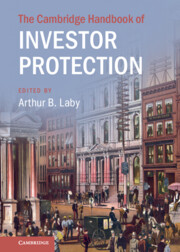Book contents
- The Cambridge Handbook of Investor Protection
- The Cambridge Handbook of Investor Protection
- Copyright page
- Dedication
- Contents
- Contributors
- Acknowledgments
- Introduction: Continuity and Change in Investor Protection
- Part I Institutionalization and Investor Protection
- 1 The Financialization of Corporate Governance
- 2 “Public” Mutual Funds
- 3 The Overlooked Effects of Passive Management
- 4 Retail Investor Protection and Empowerment: Reflections from the European Union
- 5 Which Investors to Protect?
- Part II The Scope of Investor Protection Regulation
- Part III The Regulation of Market Professionals
- Part IV Alternative Regulatory Regimes
- Index
5 - Which Investors to Protect?
Evolving Conceptions of the American Shareholder
from Part I - Institutionalization and Investor Protection
Published online by Cambridge University Press: 20 October 2022
- The Cambridge Handbook of Investor Protection
- The Cambridge Handbook of Investor Protection
- Copyright page
- Dedication
- Contents
- Contributors
- Acknowledgments
- Introduction: Continuity and Change in Investor Protection
- Part I Institutionalization and Investor Protection
- 1 The Financialization of Corporate Governance
- 2 “Public” Mutual Funds
- 3 The Overlooked Effects of Passive Management
- 4 Retail Investor Protection and Empowerment: Reflections from the European Union
- 5 Which Investors to Protect?
- Part II The Scope of Investor Protection Regulation
- Part III The Regulation of Market Professionals
- Part IV Alternative Regulatory Regimes
- Index
Summary
Any system of investor protection rests on a theory of which investors to protect. Policy inevitably demands tradeoffs between distinct constituencies with divergent needs. Institutional investors are quite different from individual investors. A billionaire investing through a family office has distinct concerns from a middle-class investor. Tastes and preferences for regulation may differ, too, even within an apparently homogenous category. One retail investor may have unusually high tolerance for risk, or may enjoy day-trading and speculating, even at the expense of higher returns. Another retail investor may be focused on saving for retirement, have little interest in the task of picking investments, and primarily want oversight and protection from the perils of the market.2
- Type
- Chapter
- Information
- The Cambridge Handbook of Investor Protection , pp. 95 - 114Publisher: Cambridge University PressPrint publication year: 2022

